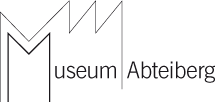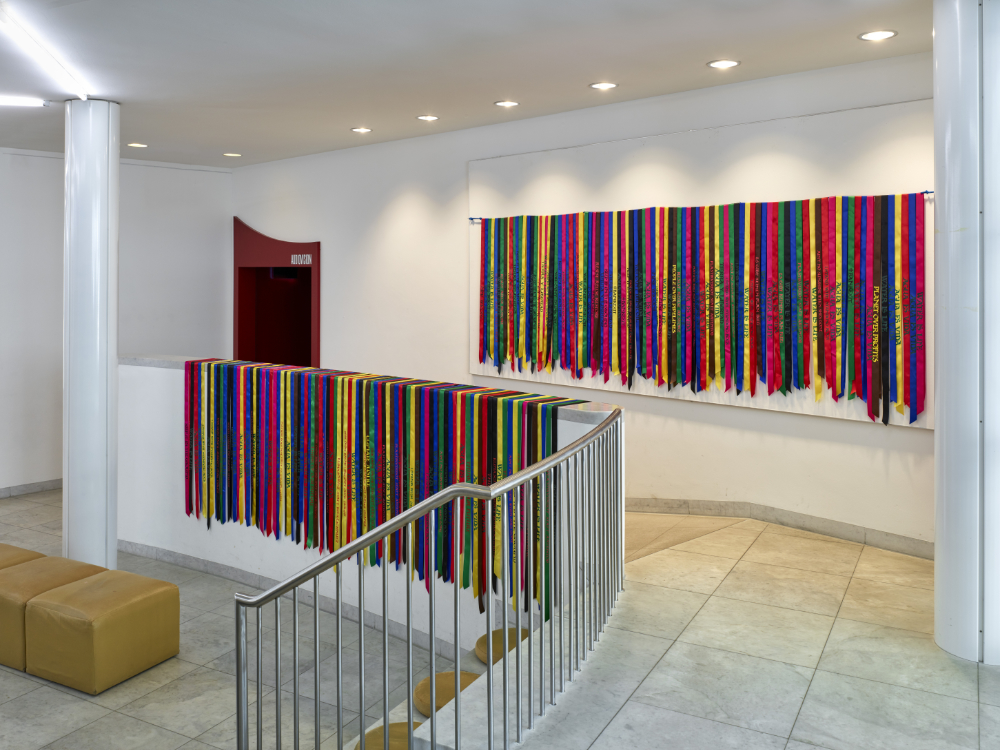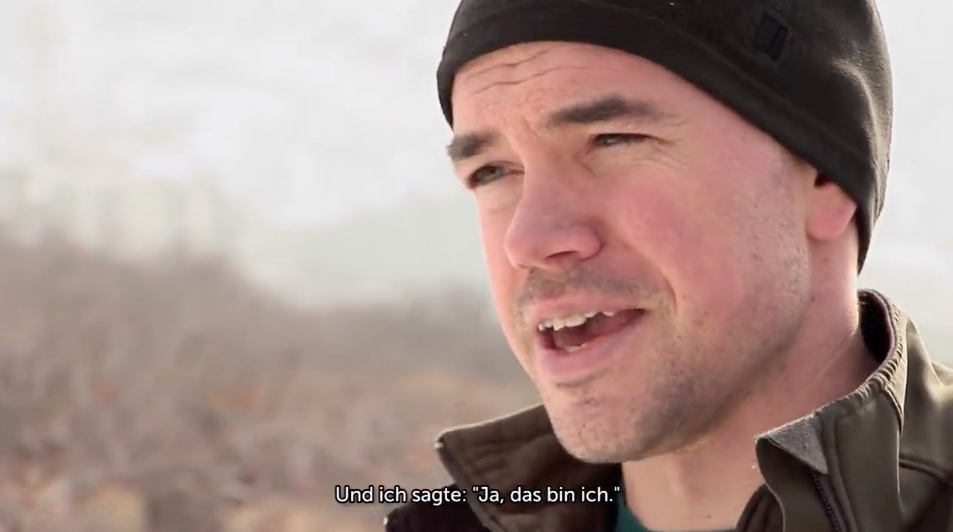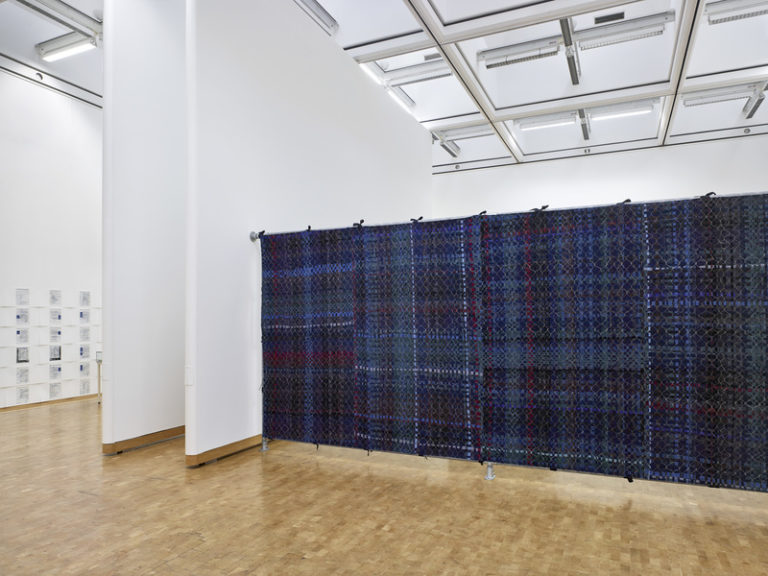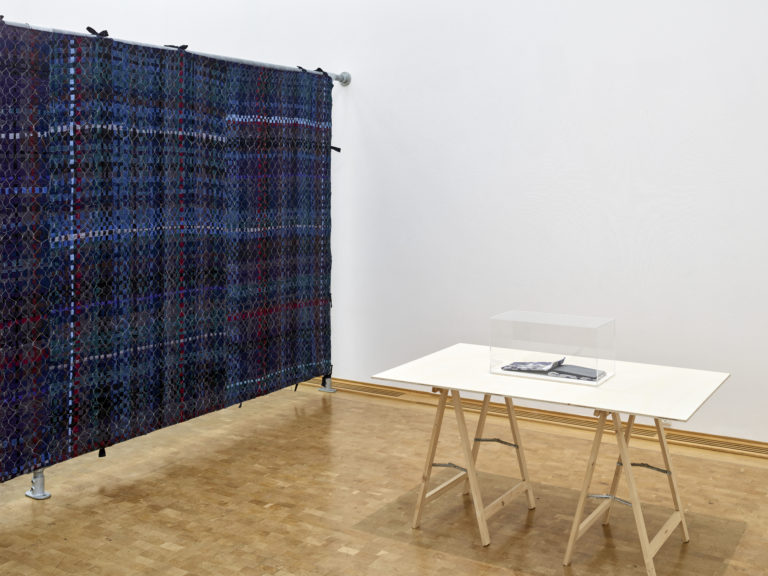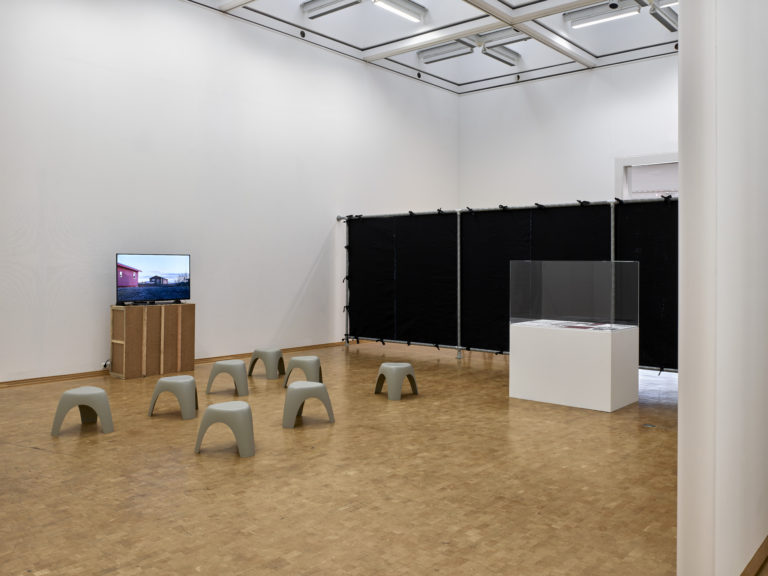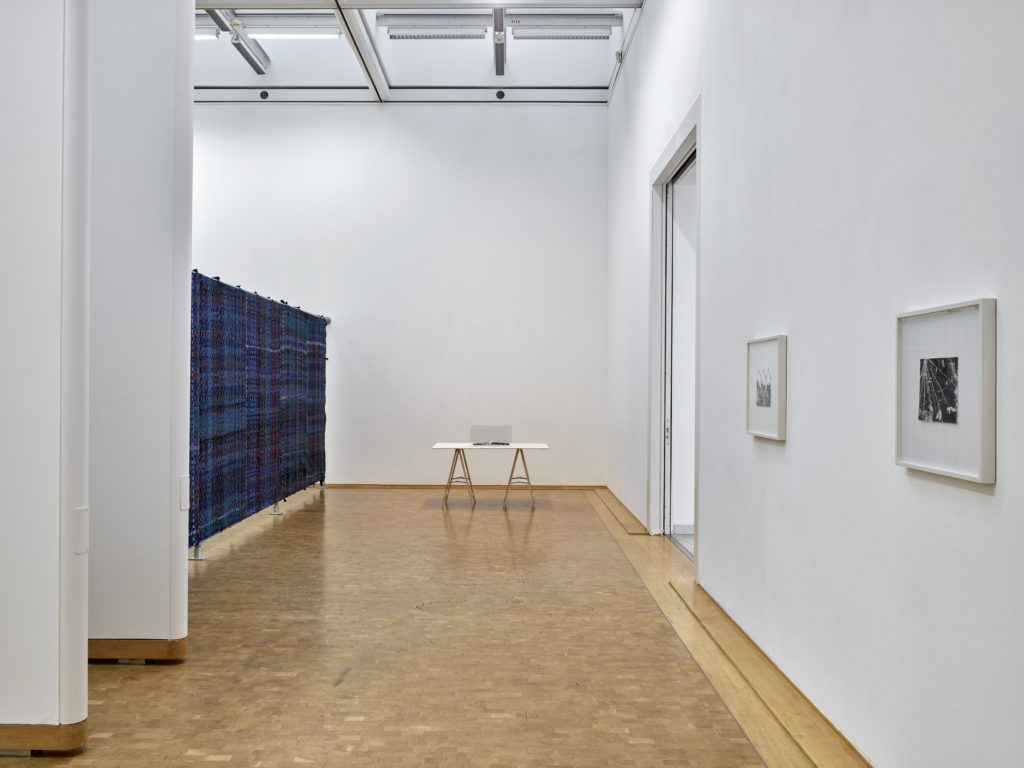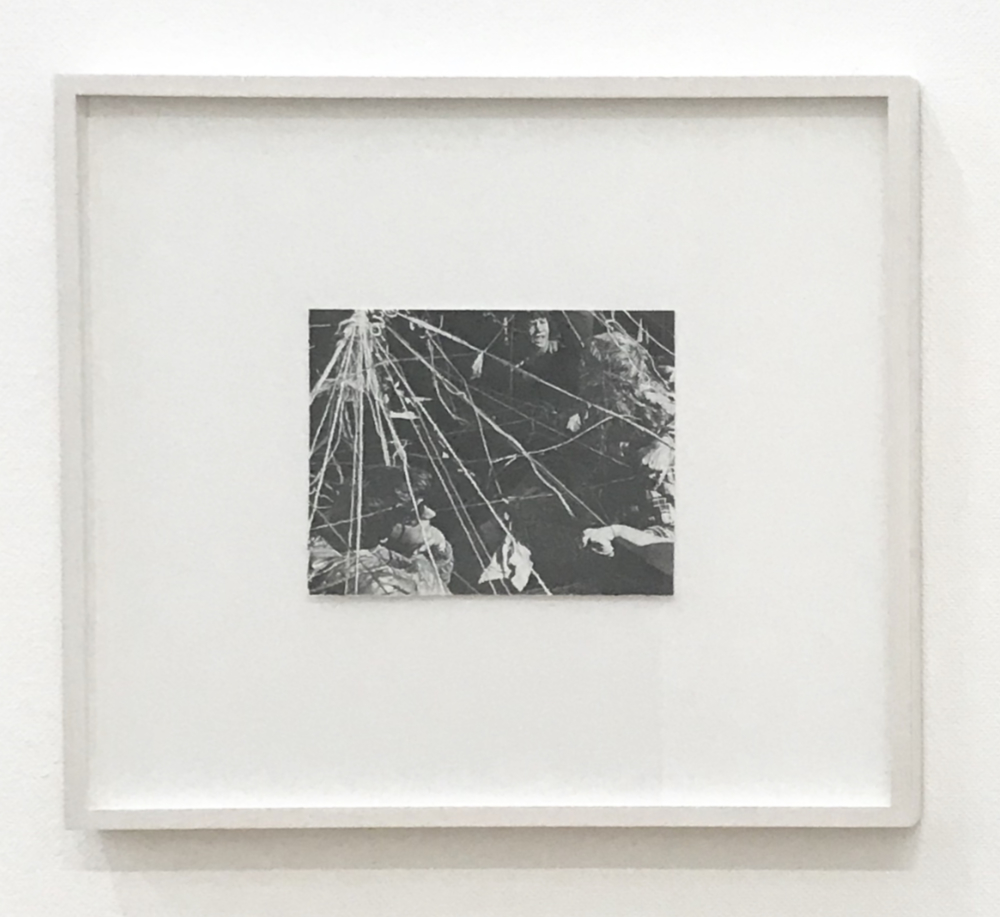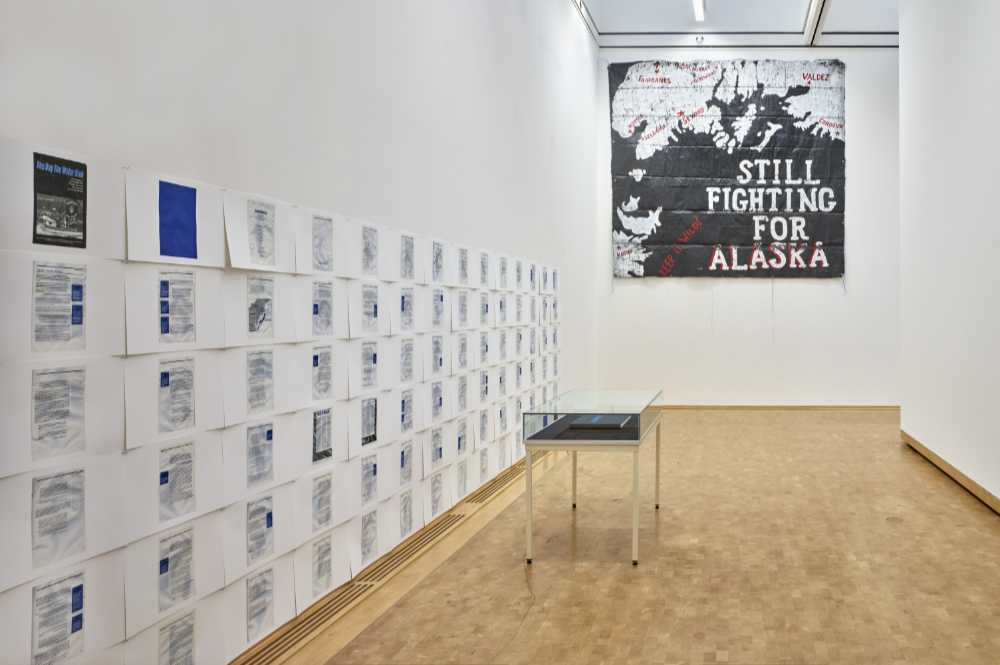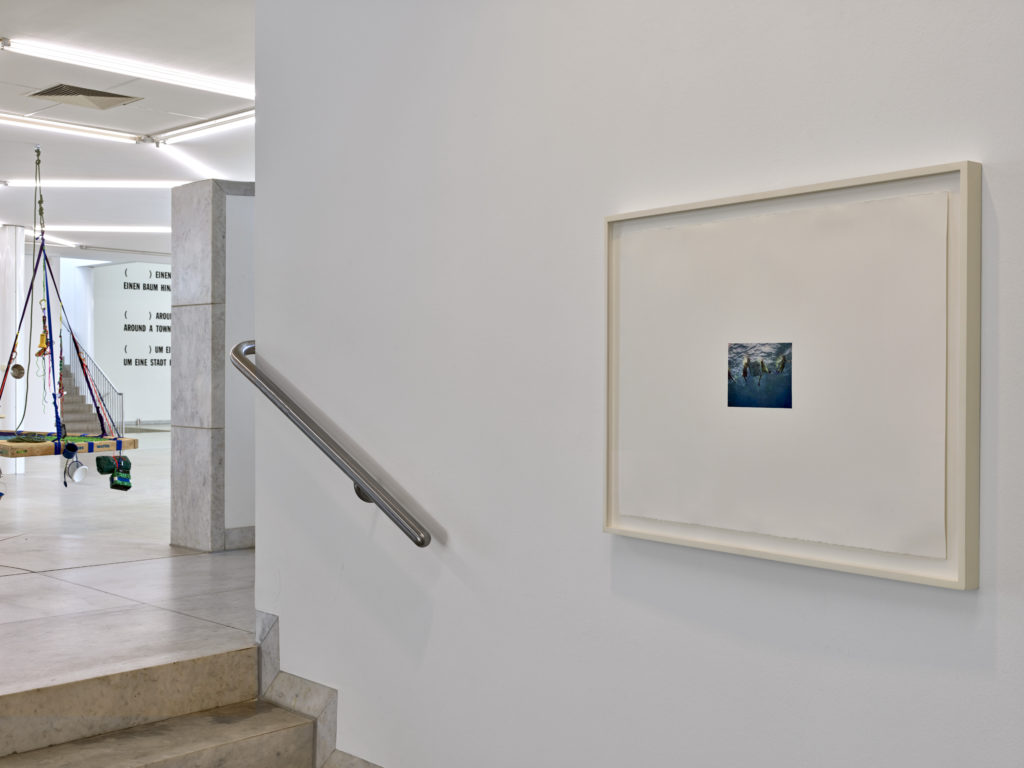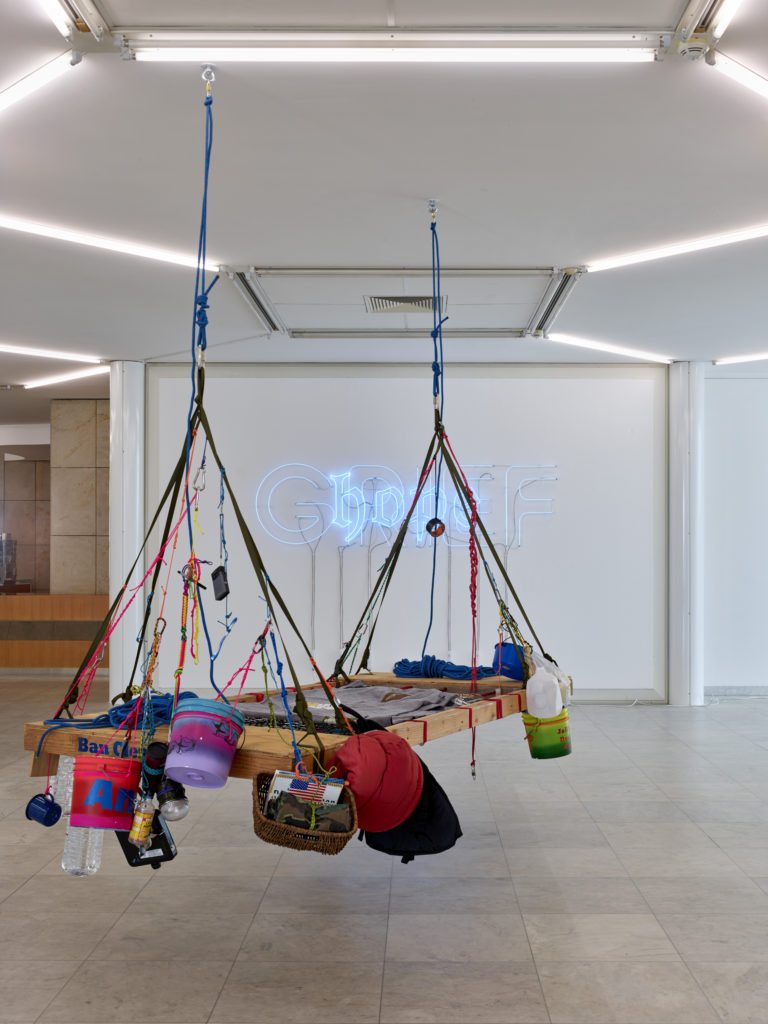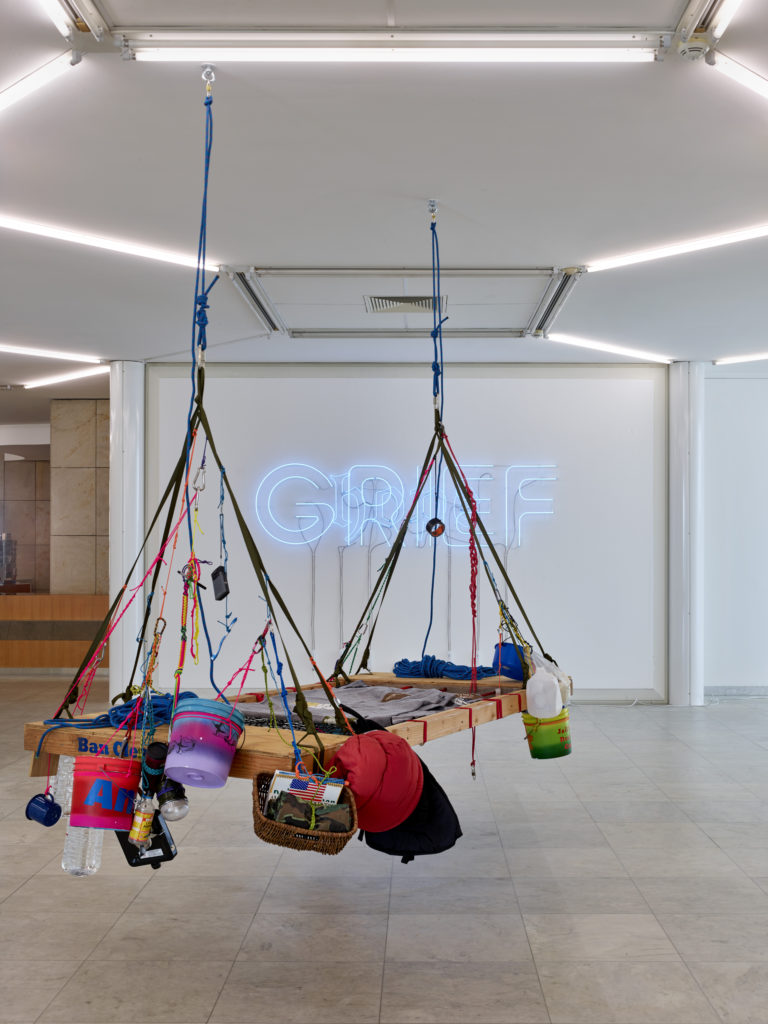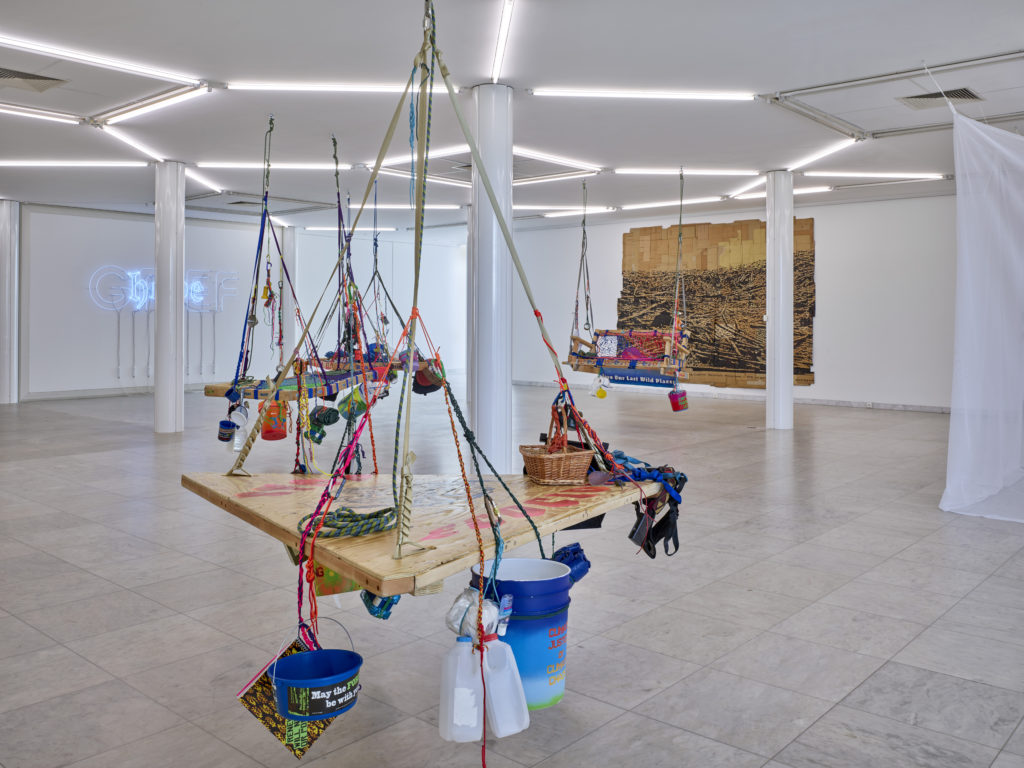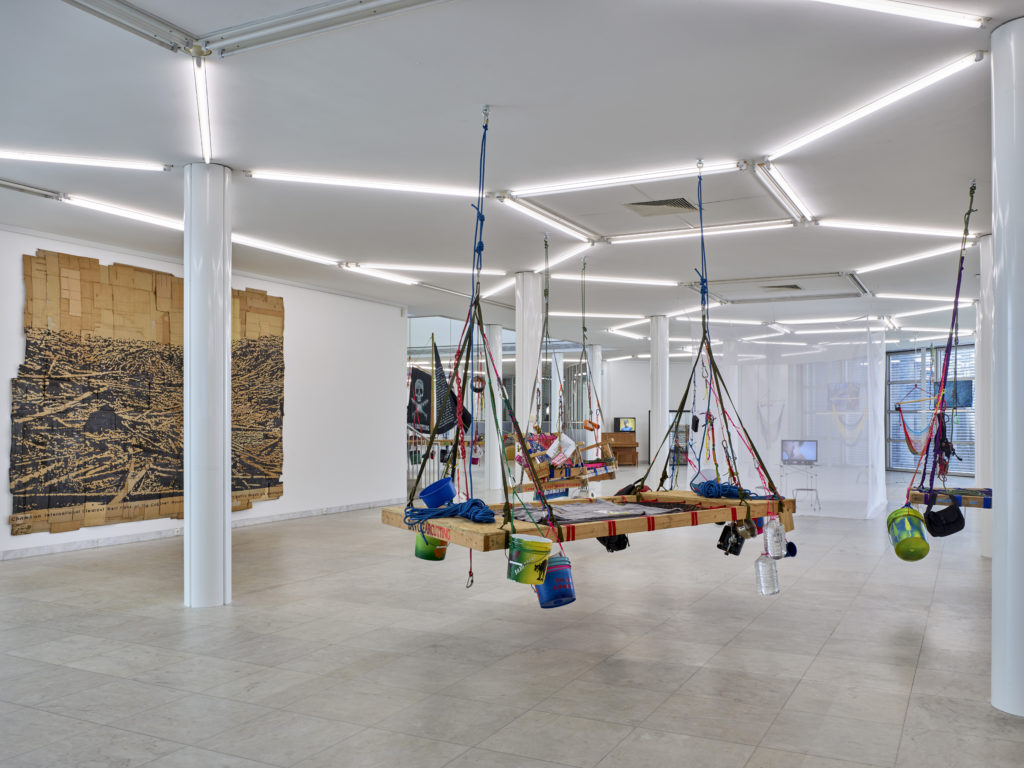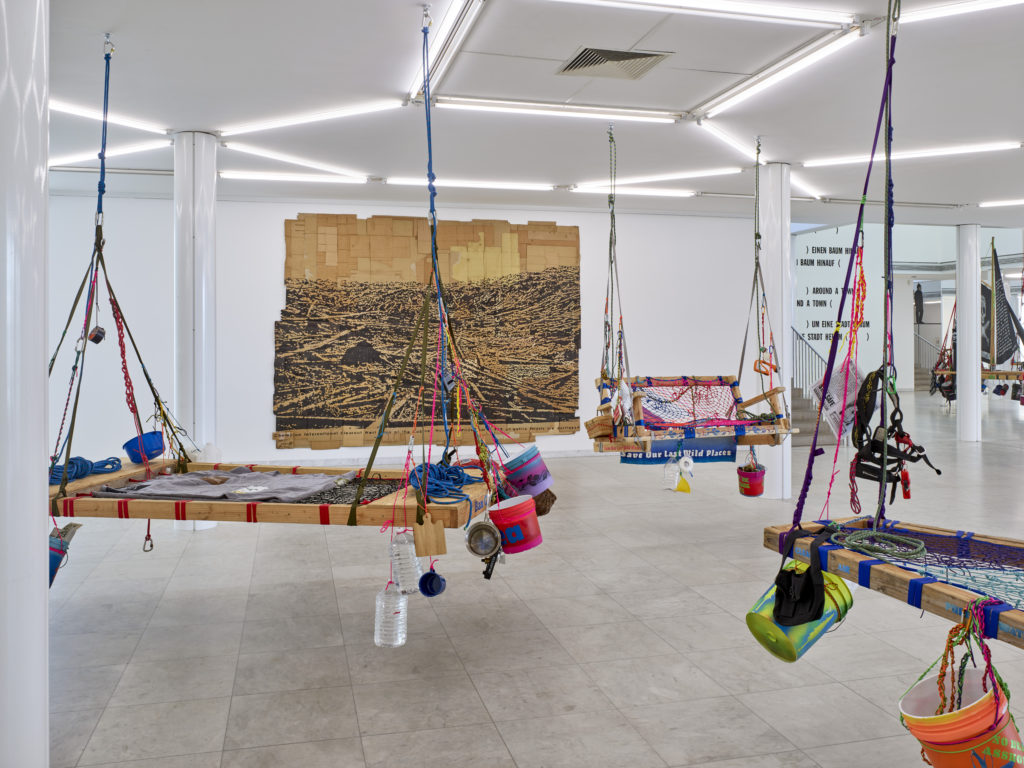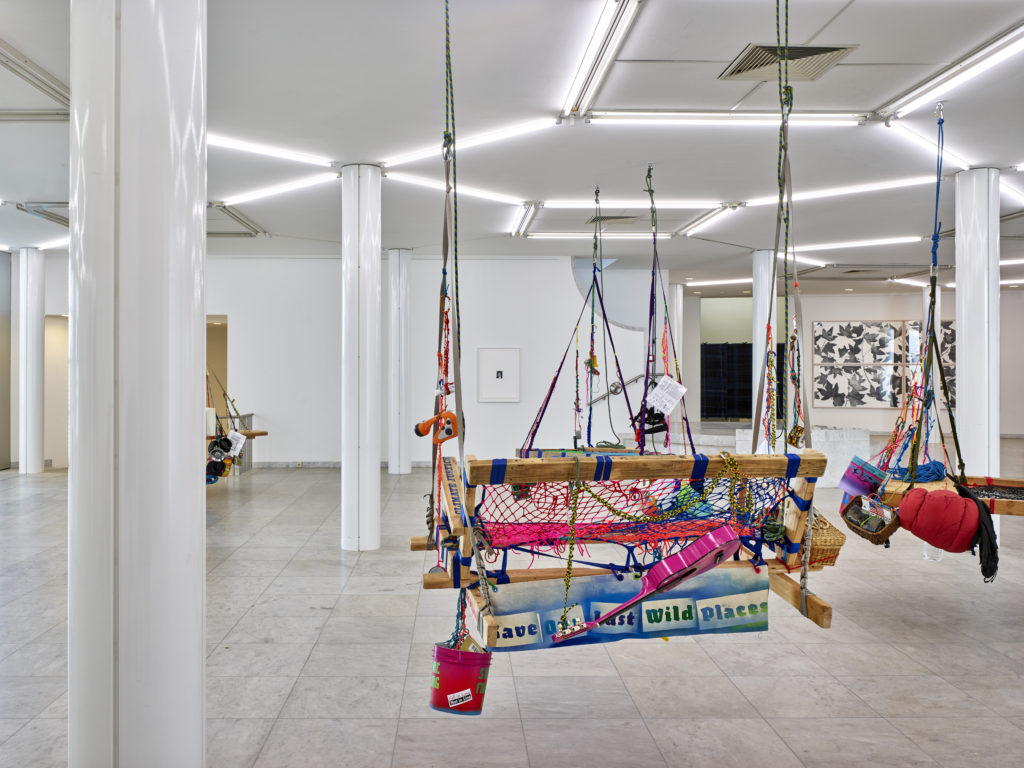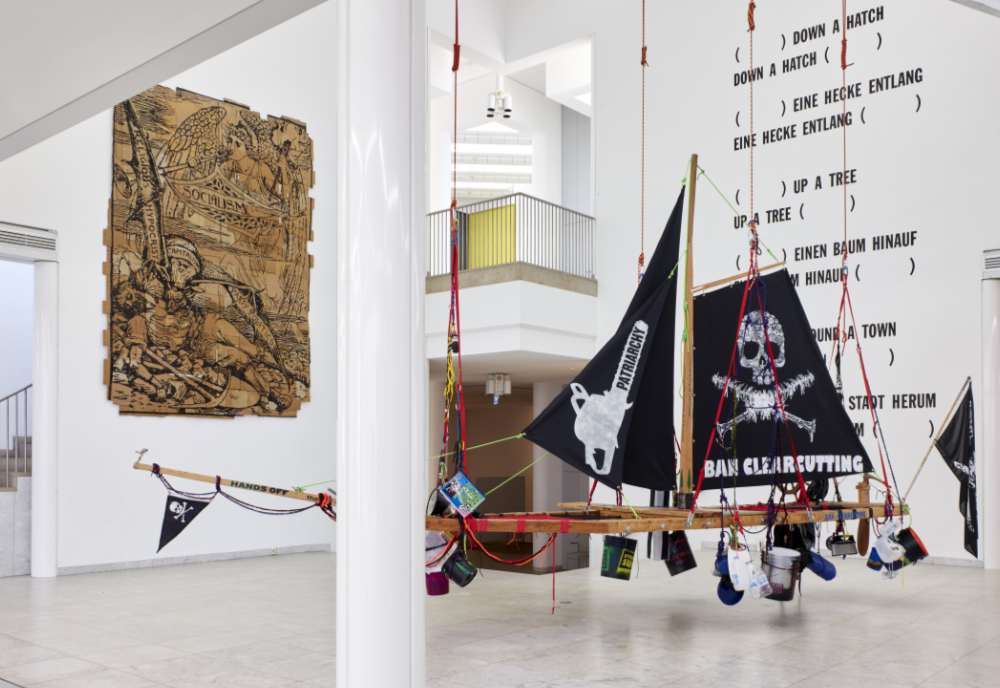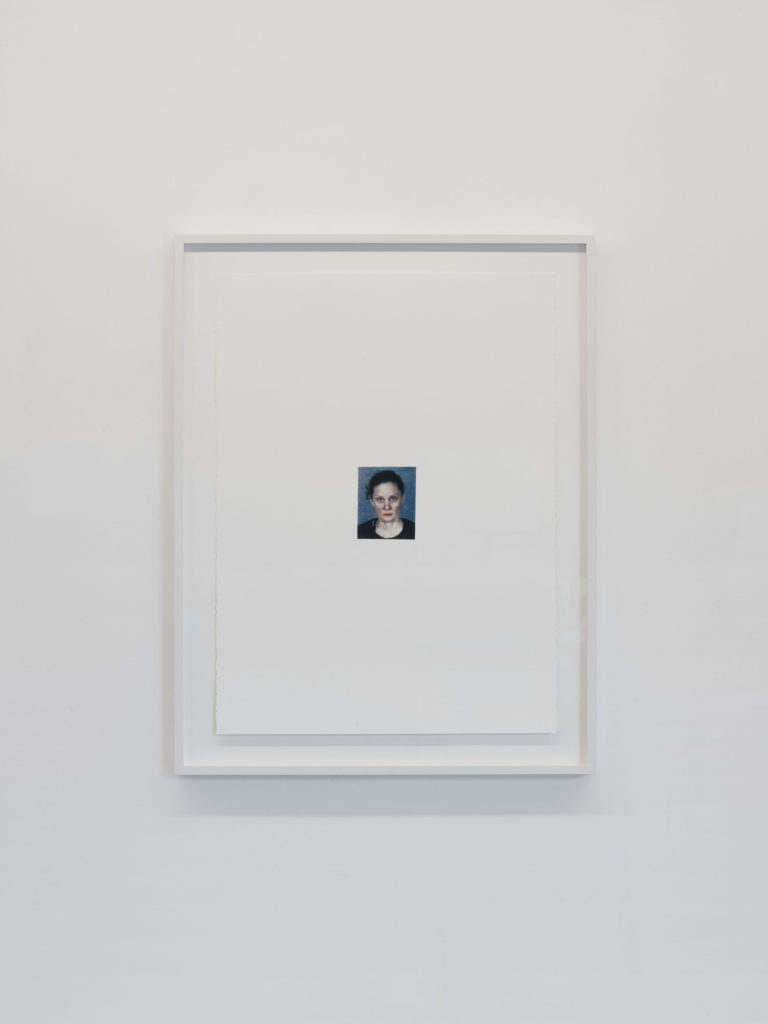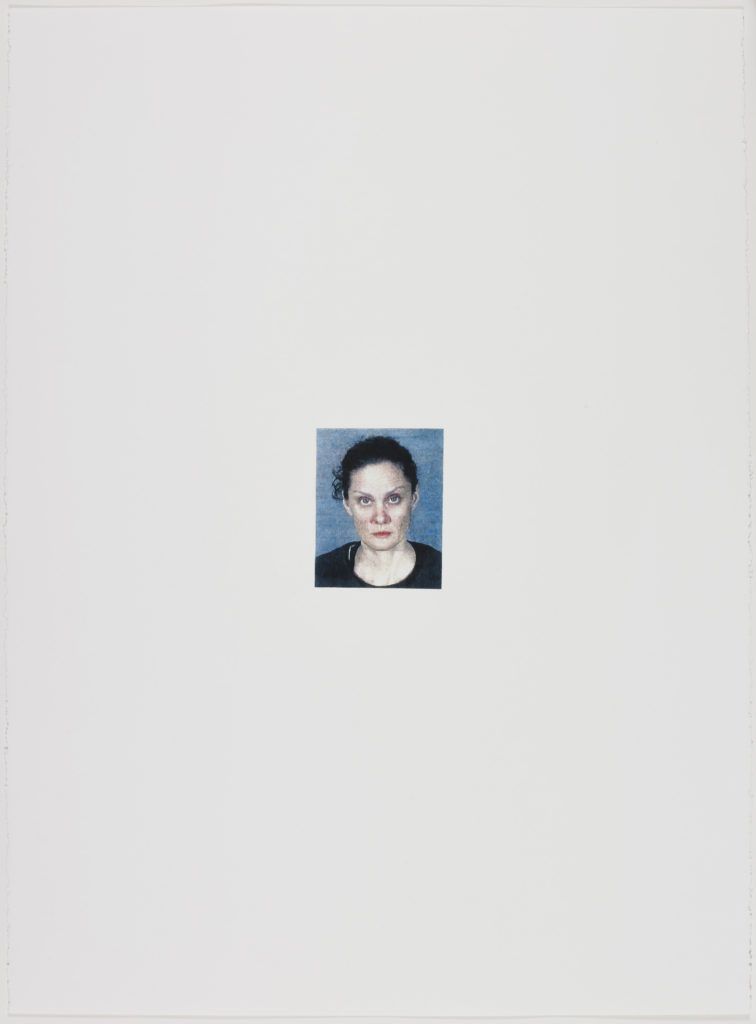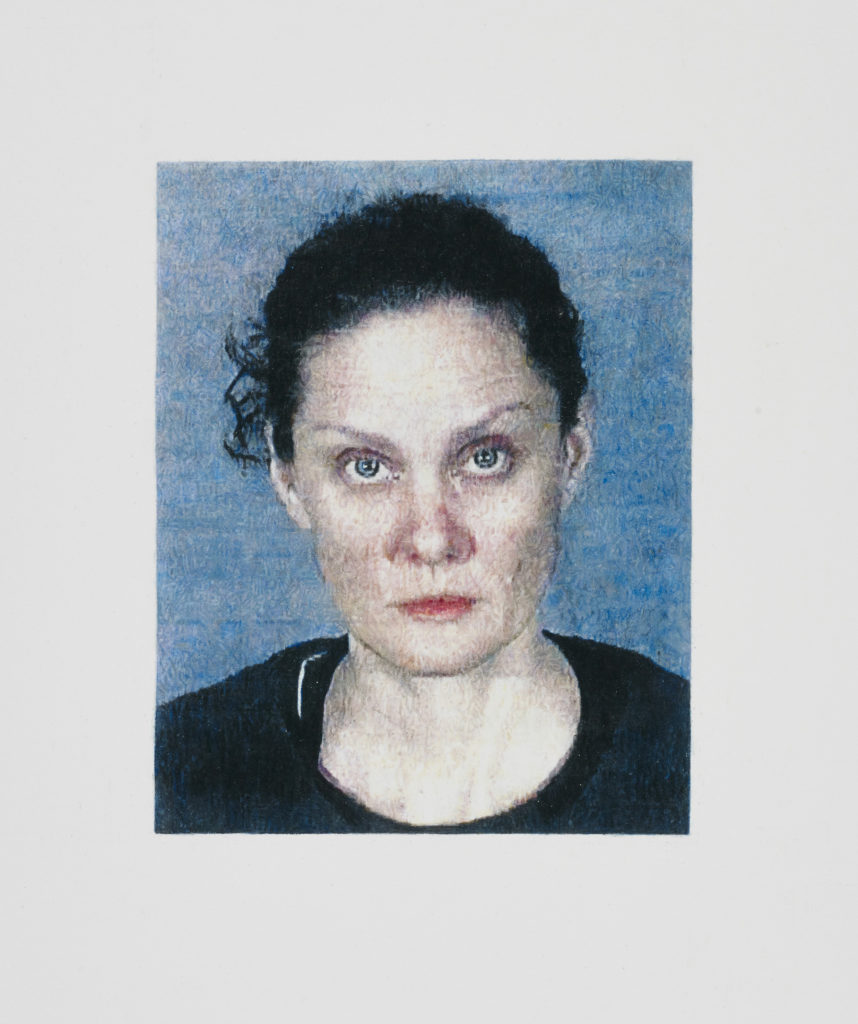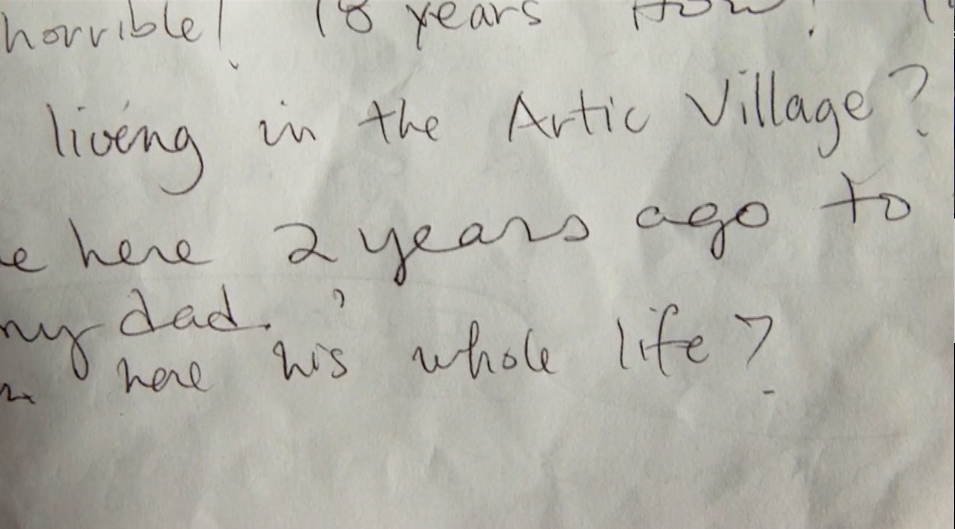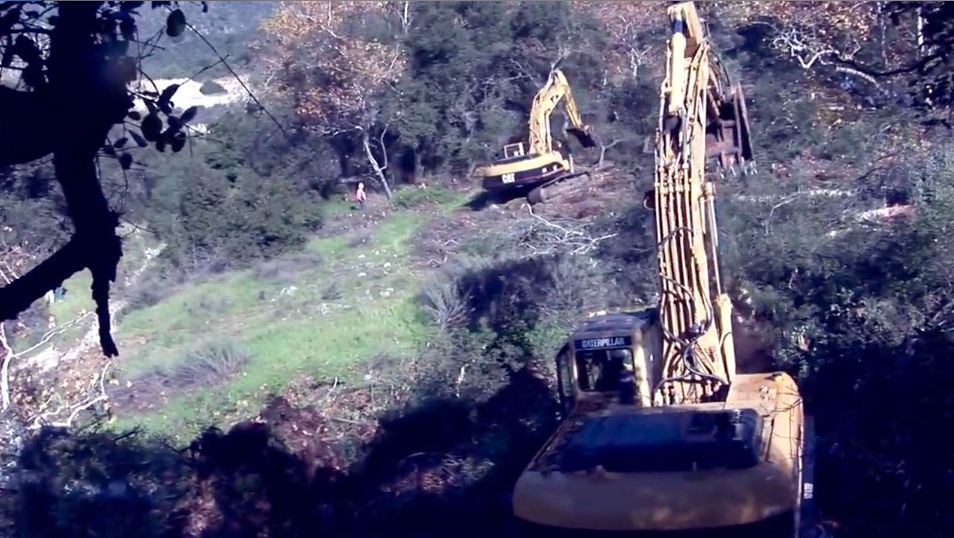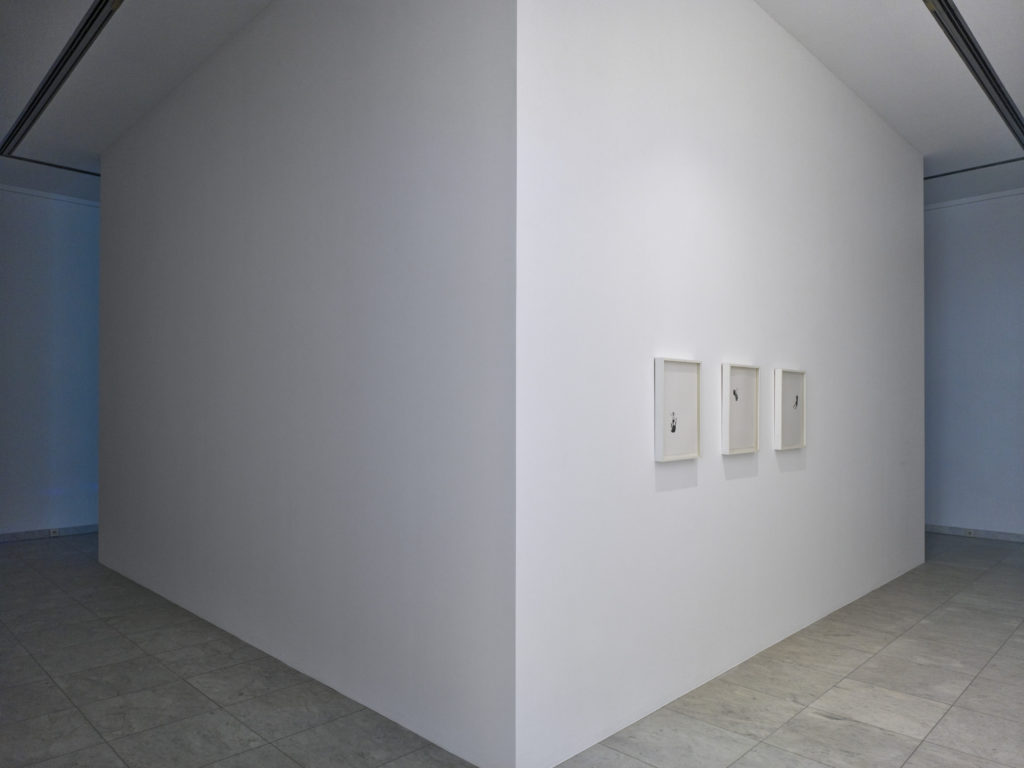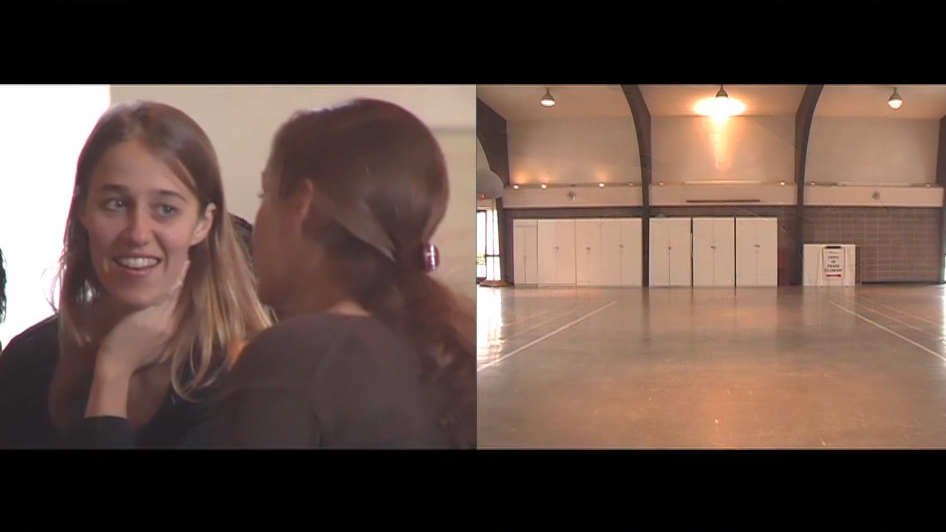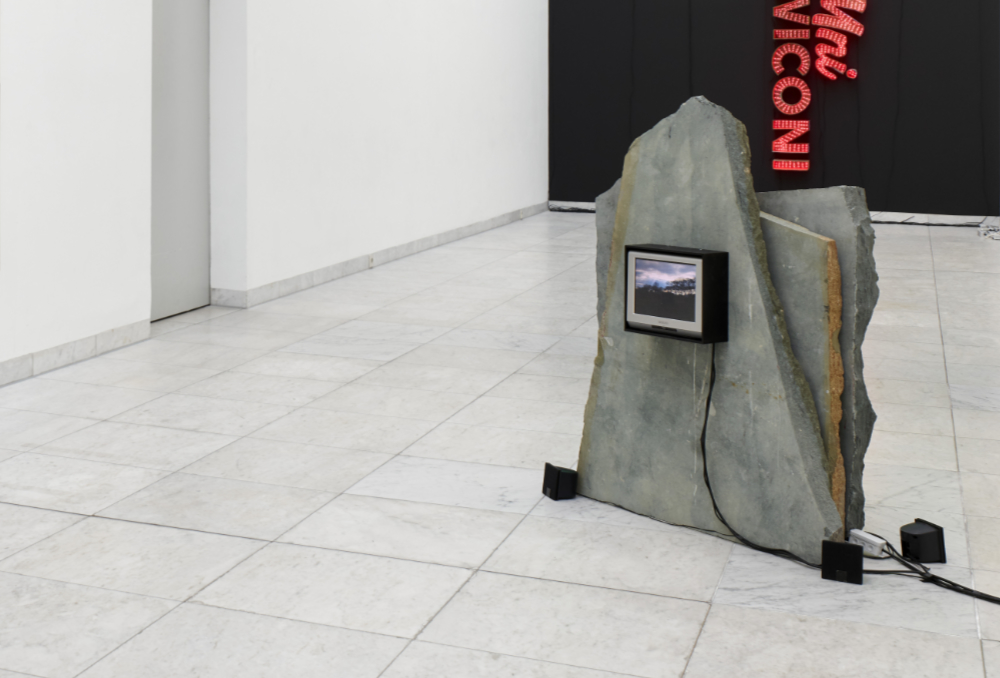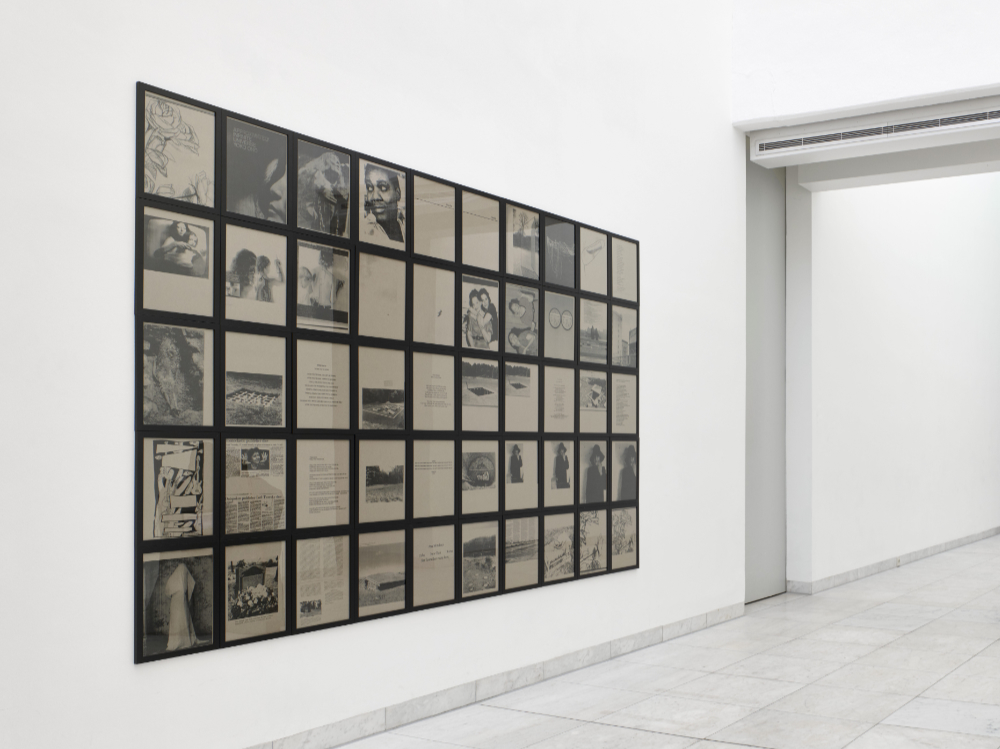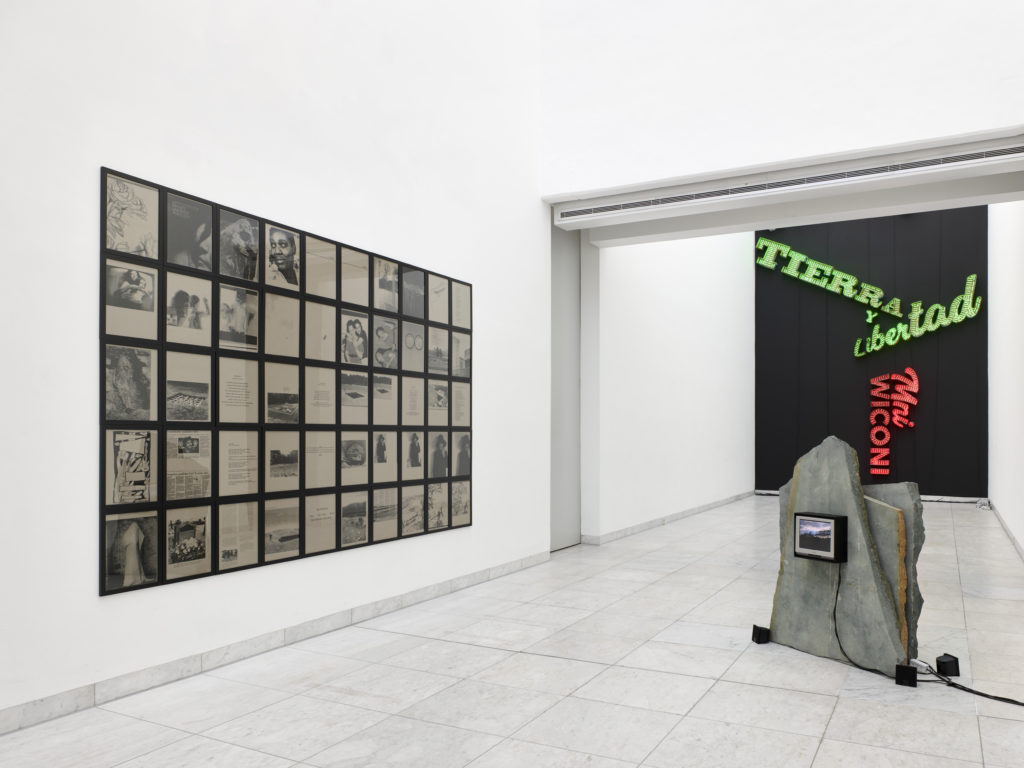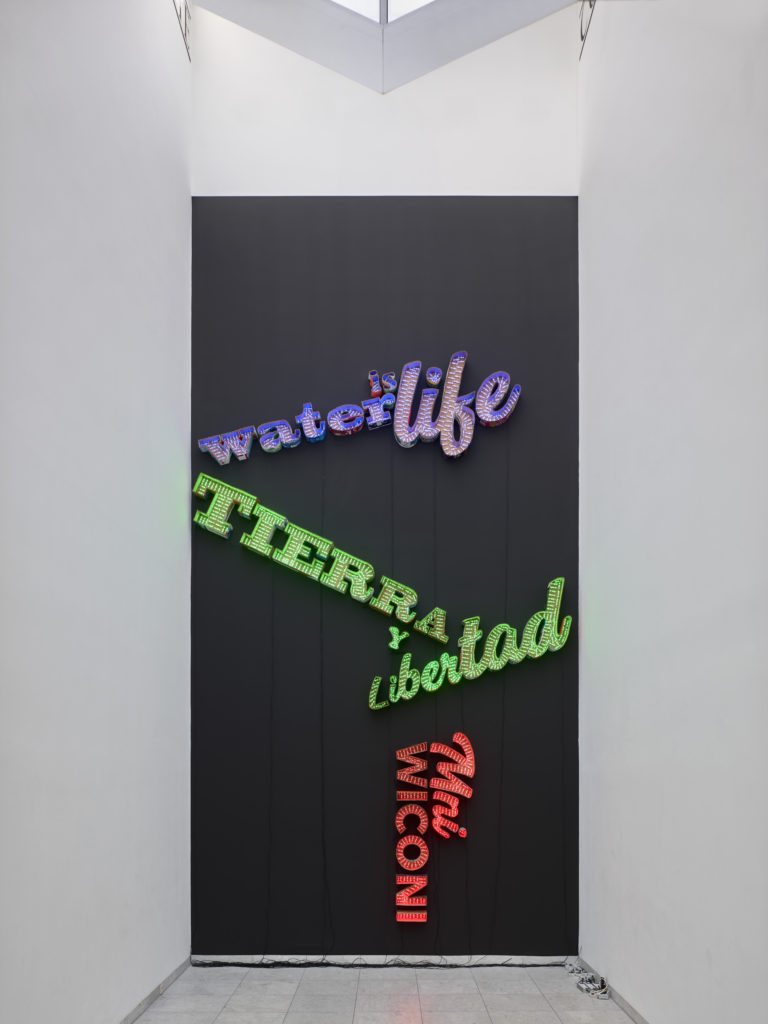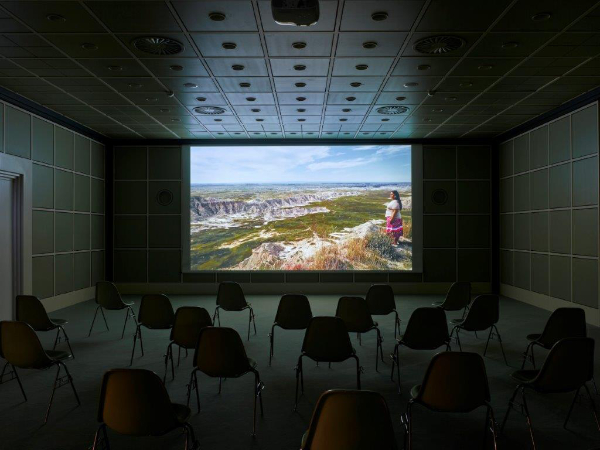Political Ribbons for Abteiberg,
2020
This piece was first made for an exhibition at the Hammer Museum in 2017. The shared sentiments of Food & Water Watch and the South Central Farm were evoked in a series of multicolored takeaway ribbons, screen-printed by hand with various statements reflecting the concerns of the #NoDAPL movement and the broader commitments to sustainable agriculture and clean water. As the project continued to be shown at different institutions, the slogans evolved but always directly underscore the current issues relative to the local museum community. Bowers’ long-standing commitment to environmental advocacy has formed the basis of her artistic work and the statements are offered here as personal calls to action. This project reflects her interest in gift culture; viewers are offered the opportunity to take a ribbon from the wall. With generous support from Vielmetter Los Angeles, Andrew Kreps Gallery New York and Capitain Petzel Berlin.
The United States v. Tim DeChristopher
2010
16:15 minutes
The United States v. Tim DeChristopher is a single channel video focusing on a Utah student who, posing as a bidder, disrupted a government auction of 150,000 acres of wilderness for oil and gas drilling as an act of civil disobedience. In December 2008. Tim DeChristopher bid for and won 14 parcels (22,000 acres) of land near Arches National Park and Labyrinth Canyon worth $1.8 million — and then announced that he had neither the intention nor the money to pay for them. Once authorities realized what DeChristopher was doing the auction was stopped and he was arrested. Many of the leases, which would have permitted drilling on pristine acres of public land in Utah, including some of America’s most beautiful and environmentally sensitive red-rock desert, were subsequently canceled. But for DeChristopher, there have been serious consequences. He was charged with making false statements and interfering with an auction and faces up to 10 years in prison and fines of $750,000. On July 26, 2011, DeChristopher was sentenced to two years in prison and a $10,000 fine. Bowers’ video includes an interview with DeChristopher and footage of the artist walking through the parcels of land that the activist won in the auction.
Soft Blockade
2004
Soft blockades are human barricades such as forming a line and linking arms using no gear except the human body. These blockades can involve one person or thousands of people in nonviolent direct action, and can be a stand-alone tactic or an element of a larger tactic, like an occupation. Upon entering the gallery one is blocked by a needlepoint representation of a chain link fence on a woven tapestry. The piece references the first Woman’s Pentagon Action in Washington DC during which the doors of the Pentagon were woven shut with symbolic webs to protest nuclear reactors. Weaving as spider webs was used as a metaphor for women’s power against patriarchal institutions and was the vehicle for numerous other protests in the 1980s.
Women’s Pentagon Action, Detail of Woven Web Around Pentagon (1981)
Diabloblockade, Diablo Nuclear Power Plant, Abalone Alliance (1981)
2003
These two drawings originate from newspaper photos of protestors behind fencing at Diablo Canyon Nuclear Power Plant in California, September 1981; and The First Women’s Pentagon Action, November 16-17, 1980. Collection of Gaby & Wilhelm Schürmann; Herzogenrath.
Mavis Muller – Alaskans Still Fighting for the Earth Banner
2009
The Day the Water Died
2009
Works include a banner, originally displayed by enviromental activist Mavis Muller on a trawler in the poisoned Alaskan waters during the 1989 Exxon Valdez Oil Spill, accompanied by a hand-made book titled “The Day The Water Died,” personal accounts of locals’ experience of living through the oil spill. While in the Arctic Village, Bowers met community members from Prince William Sound who told stories about how the land and economy still had not recovered from the Valdez spill almost 20 years later.
Circle
2009
17:03 min
Circle is a video that combines panoramic landscapes with interviews and footage of four generations of women from the Arctic Village. These women, some of whom are part of the activist organization, The Gwich’in Steering Committee, eloquently express the urgent needs of their people for the prevention of oil drilling in the Arctic National Wildlife Refuge and the protection of their lands from global warming.
Step It Up Activists, Sand Key Reef, Key West, Florida, Part of North America’s Only Remaining Coral Barrier Reef, 2007
2009
This drawing is based on a photo of the Step It Up activists raising awareness of the environmental issues affecting Sand Key Reef in Key West Florida, part of North America’s only remaining coral reef.
Grief Hope
2020
Environmental Grief is experienced from the loss of our natural world and its creatures. As our global freedoms decline, Bowers is trying to move from grief to hope by focusing on activists and political actions as the subject of her work. Graphic design by Julieta Gil
Clean Air Pure Water Healthy Land Tree Sitting Platform for Forest Defense, 2012
recycled wood, rope, carabiners, misc. equipment and supplies
Stop Ecocide Tree Sitting Platform for Forest Defense, 2012
recycled wood, rope, carabiners, misc. equipment and supplies
Tree Sits – Canopy Camping, Earth First! Direct Action Manual with Dream Platform, 2011
recycled wood, rope, carabiners, misc. equipment and supplies
Charlotte Feng Ford Collection, New York
Tree sitting speaks to the highest level of forest defense and has have been very successful in halting logging all over the world. It is a form of environmentalist civil disobedience in which a protester sits in a tree, usually on a small platform built for the purpose, to protect it from being cut down. Included in this exhibition is a selection of sculptures from Bowers’ series of tree sitting platforms. These works focus on climate justice and feminist subjectivity in art and activism. One of the activists from the Arcadia tree sit, a veteran tree sitter who spent over six years living in old growth redwoods throughout Humboldt County in Northern California, helped her fabricate all of these works. As in many of her projects Bowers is celebrating craft; in this case, the activist’s carpentry of reused and recycled wood and his exceptional knot tying.
Radical Feminist Pirate Ship Tree Sitting Platform
2013
Bowers asked a male tree sitter what his fantasy tree sitting platform would be. As she said, “All of my frustration, insecurities and inequalities of living in a patriarchal culture flooded over me with his two words: Pirate Ship. I was immediately annoyed and unamused, of course. A typical man, I thought. Somehow it was so obvious yet, I would never have thought of that. For years I’ve been negotiating the gender imbalances in both art and activism. Together the Humbolt activist and I built a 25 foot a feminist pirate ship tree sitting platform.
I Am Nature: Champion International Clear-cut; West Flank of the Cabinet Mountain Wilderness
2013
A large drawing made on collaged recycled cardboard
with black marker monumentalizes an environmental activist flier. This work reproduces a photocopied flier of a
clear cut forest from an Eco-Defense zine, that enlarged, fluctuates between
abstraction and representation. Bowers muses that this is her way of making
Pollock into an ecofeminist.
Mug Shot
2013
This is a self-portrait drawing of the artist’s mug shot taken at the time of her arrest for tree sitting in 2013.
Interview with Betty Ann
2009
Interview with Betty Ann continues Bowers’ interest in storytelling but for the first time she turns the camera on herself to tell a story about her correspondence with a deaf woman and bead artist that she met at the Arctic Village.
Nonviolent Civil Disobedience Training
2004
Nonviolent Civil Disobedience Training is essentially a training video. In this two channel video projection illustrates on the left screen a seminar of non-violent action to an audience of young classically trained dancers. The other screen portrays the students physically acting out what they have learned. The choreography of non-violent protest holds a strong resemblance to early modern dance championed by Halpern and Rainer. Implicit is the political underpinnings of their art from in its break from traditional choreography and empowerment of women.
I Plan to Stay a Believer-The Arcadia 4 Tree Sit
2013
In 2011, the artist was arrested, with three other activists, for climbing into the trees of a native oak woodland habitat in Arcadia, CA and trying to save a pristine forest of 250 trees from being clearcut by the county of Los Angeles. One of the horrible and unanticipated outcomes of this action was that all of trees were ripped out of the forest around them as they were tied to the canopies of two of oaks. All of the destroyed trees were then put in woodchoppers. Ultimately Bowers was arrested on three misdemeanor charges and placed in jail for two days. She videotaped the entire experience until the sheriffs took her camera into evidence. The video, I Plan to Stay a Believer (2013) includes her footage, news footage and the sheriff department’s recordings.
Nonviolent Civil Disobedience Drawing- Go Perfectly Limp and Be Carried Away, 2004
I discovered the idea of “magical politics,” in Barbara Epstein’s book Political Protest and Cultural Revolution. Magical politics was a nonviolent, direct-action movement that arose during the early 1980s in the United States and combined feminism, spiritualism, and environmentalism. The majority of their actions centered on the arms race and its impact on the environment, and some of the actions realized by the women’s affinity groups involved in this movement took place at sites such as the Pentagon, the Diablo Canyon Nuclear Power Plant in California, the Seneca Army Depot in upstate New York, and the U.S. Department of Energy’s Nevada Test Site north of Las Vegas. The name “magical politics” was coined by Barbara Epstein, though I doubt any members of the movement are even aware of this term. It refers to the movement’s spiritual makeup, which constituted an alliance between radical leftist Christians (mainly Catholic and Protestant groups such as the Catholic Workers, Jonah House, Atlantic Life Community, and Ground Zero) and feminist pagans. There is an absurdity in the union of these groups’ faiths that is at once humorous and utopian. Their ability to work together effectively was an amazing accomplishment, especially considering the fraught interactions of other opposing religions around the world. Viewed from the current climate of religious fundamentalism in the United States and throughout much of the world, the collaborative spirit of the magical politics groups presents an almost unimaginable model of acceptance of others’ differing beliefs.
Bowers’ drawing triptych places a heroic spotlight on an anonymous subject and acts as a reminder that the impact of many results from the power of one. The work takes its inspiration from feminist activists throughout 20th century protests while referencing her love of choreographers such as Anna Halpern, Yvonne Rainer, and Simone Forti. Charlotte Feng Ford Collection, New York.
Nonviolent Civil Disobedience Training- Tree Sitting Forest Defense, 2009
33:50 min. (looped); Single-channel video with color and sound, TV and Platform (lent by John Quigley, Environmental Activist. It was used in South Central Farm Tree Sit, 2006 Los Angeles CA)
This video, one in a series of training videos, documents a tree-climbing lesson given to Bowers by environmental activist, John Quigley. This piece, focusing on the metaphor of ascension, encapsulates the good intentions and hopes of the environmental movement and continues Bowers’ exploration of choreographic movements resulting from political action.
After You’ve Gone
2002
After You’ve Gone is made of 3 large pieces of stone, 2 video monitors and a sound system. The project began when I learned that Janis Joplin helped pay for a tombstone on Bessie Smith’s unmarked grave and then 2 months later Joplin died. The front video loops a 7-minute shot of the back of Bessie Smith’s grave in PA. The only movement occurs in the sky. The back video plays a 30-second clip that loops first forward and then in reverse of the inscription on the front of her tombstone, “The greatest Blues singer in the world will never stop singing.” The sky is clearly reflected on the surface of the tombstone. The sound is looped in two parts: first Bessie Smith is layered onto Nina Simone both singing “After You’ve Gone” and secondly Nina Simone is layered onto Janis Joplin singing “Little Girl Blue.”
Battlefields, Gardens and Graveyards (Sentimental Scrapbook Displayed)
2002
Battlefields, Gardens and Graveyards (Sentimental scrapbook displayed) and After You’ve Gone were part of the exhibition From Mouth to Ear. I was looking for a way to use repetition and imitation as a model for invention and creativity. The title, From Mouth to Ear, is a reference to storytelling, a different kind of historical recording. This was the first project in which the research was displayed directly as the final work. I was thinking about the formation of artistic identity. This was a project about my subjective historical influences in art, music, and writing, all of which dealt in some way with familial heritage—the tradition of passing information from one generation to the next. In the process of looking for influences and role models, I began to perceive a historical gender imbalance. At that time, there were so few publications or exhibitions of women artists to access as influences. I started to work on a positive model of historic precedence through the use of repetition to pay homage and memorialize. Battlefields, Graveyards and Gardens-Sentimental Scrapbook Displayed contains photocopies of source material, a subjective grouping of artists, musicians, and writers that were personally influential whose artistic practice served as memorials to other artists or illustrated a model for making art that portrayed a positive familial relationship.
It Gives Me Life
2017
Constructed from repurposed cardboard, the three texts– Water Is Life, Tierra y Libertad (land and liberty in Spanish), and Mni Wiconi (water is life in Lakota) – form direct links between environmental sustainability and recent divestment campaigns, the #NoDAPL movement, and the global support of indigenous rights. Graphic design by Marcelinda del Norte
My Name Means Future
2020
51:06 min
My Name Means Future. Centered on Tokata Iron Eyes, a member of the Standing Rock Sioux tribe who has been involved with the movement to stop the Dakota Access Pipeline since its inception, the video continues Bowers’s commitment to documenting important activists of her time. Bowers asked the young activist to show her some of her most sacred places in South Dakota. With a small group of friends – all artists and activists, they traveled together for 4 days in September recording video interviews and landscape drone shots of the youth activist discussing the landscapes, their histories, as well as the personal and political issues that arose from being in these sacred sites. In the Lakota language, “Tokata” means “Future”.
